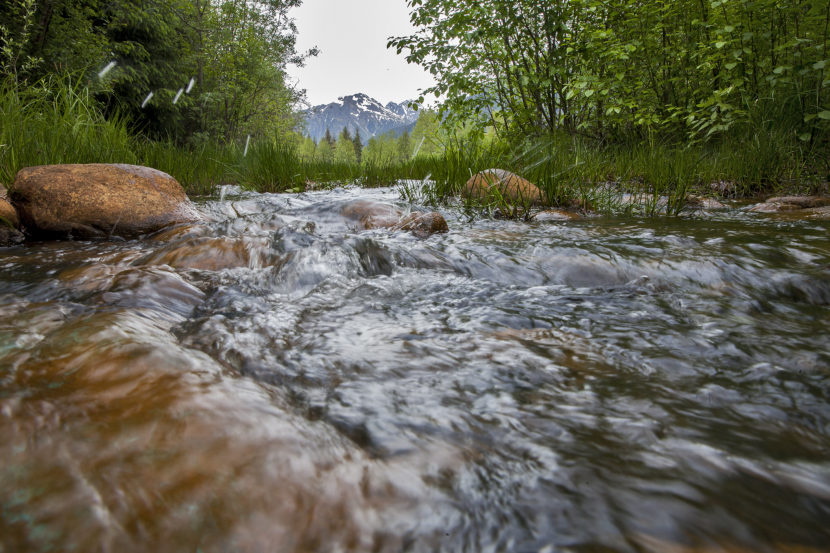Federally funded environmental science on a geologically doomed creek in Juneau could inform fish-saving restoration on other impaired water bodies.

Alaska’s Department of Environmental Conservation has announced nearly $300,000 in grants to improve water quality in some of the state’s most damaged watersheds, including the orange-tinted Duck Creek.
As it is, the bird calling and chitter of the occasional ground squirrel are consistently drowned out by traffic from the road to the west and noise from the neighborhood that runs along the east end of the wetland. Similarly, Duck Creek has suffered a loss of fish habitat and a decline in water quality from at least 50 years of that same type of development in Juneau’s Mendenhall Valley.
Juneau residents might recognize it as the creek with an odd orange tint, a symptom of iron-rich groundwater. As neighborhoods and commercial developments sprung up in the valley, the creek has been diverted into ditches and culverts making it even harder to recognize as a flowing water body.
Twenty-two years ago, the state put Duck Creek on its impaired water bodies list. At the time, it was full of fecal coliform bacteria, metals and debris.
By 2001, its chum salmon run – historically up to 10,000 fish – was extinct. Its coho salmon run was fewer than 20 fish and its trout fishing, closed. The Alaska Department of Fish and Game has yet to reopen fishing on the creek.
The Nancy Street wetland habitat was one project among a long list including culvert maintenance and upgrades, revegetation of stream banks, sediment removal and stream cleanup. Next spring, scientists will begin sampling the creek’s water quality in the wetlands to see if the bio-filtering project is improving the watershed.
Amy Sumner, a biologist and project manager with the Juneau Watershed Partnership said the effort will be coordinated with the University of Alaska Southeast and train budding student biologists in water quality assessment.
“We’re hoping to see that as the water filters through the wetland the water quality is improving.”
Funding for the student position and testing of the water samples will come from a $10,000 Alaska Clean Water Action grant. The state’s Department of Environmental Conservation announced nearly $300,000 in grant funds this year for water bodies it said are in the greatest need of protection and restoration.
In Southeast Alaska, the projects include Juneau’s Nancy Street wetlands assessment, bacteria monitoring on a heavily used beach in Petersburg, and plant-filled ditches in Haines designed to filter snowmelt runoff before it mixes with a salmon stream.
Statewide, projects include an ongoing campaign to stop people from feeding ducks and other waterfowl in a popular midtown park in Anchorage, copper and zinc monitoring on the Kenai River, a beach monitoring project in Nome and a program to educate miners near Fairbanks on the impacts of turbidity and sediment on fish.
Since 2005, the state has awarded nearly $5.4 million to fund things like municipal stormwater master plans, fish passage assessments, habitat monitoring, boating education, and even septic system education for homeowners.
Cindy Gilder, a program manager at the Department of Environmental Conservation, said the grant funds come through the Environmental Protection Agency. The program has been around for decades.
Like Duck Creek, the most troubled watersheds in Alaska are in urban areas, or at least they’re the ones that get the most grant funding. Gilder said similar programs in other states are concentrated in rural areas, where agricultural runoff is often a culprit in watershed pollution.
If I looked back over the history of the grants, there’s probably, usually a grant in Anchorage, maybe in Fairbanks, in Juneau, there’s usually in Mat Su, something down the Kenai. Because a lot of non-point source pollution, it’s the non-permitted stuff. It’s you and I driving our cars and my car leaking oil or my stepping on the brake pads all the time.”
On Duck Creek, nearly $57,000 has come through the grant program to help restore the watershed.
With all the restoration in Juneau, we have not been very good about following up with water quality monitoring to see if these efforts are actually being effective. So that’s what this project is trying to accomplish. We’re going to test above the wetland, inside the wetland area and then at the wetland outlet to see if water quality is being improved as the water filters through that wetland.”
In the end, it’s probably too late for the dwindling numbers of fish who migrate in and out of Duck Creek. The Mendenhall Glacier seems to be finishing off what decades of dumping, development and diversions started.
“So as the glacier retreats our land is rebounding and that is causing Duck Creek to disconnect with some of its groundwater source that provides its base flow. So a lot of times Duck Creek will dewater and it’ll look like a dry streambed so that is providing some problems for fish getting upstream and because of that interaction between the uplift and the dewatering, Duck Creek is really no longer able to provide viable fish habitat.”
Sumner said it’s not clear how long it will take for the creek to become completely uninhabitable. But the process of restoring its water quality, and monitoring which projects were the most effective, can inform rehabilitation projects on other impaired watersheds.
Rashah McChesney is a photojournalist turned radio journalist who has been telling stories in Alaska since 2012. Before joining Alaska's Energy Desk , she worked at Kenai's Peninsula Clarion and the Juneau bureau of the Associated Press. She is a graduate of Iowa State University's Greenlee Journalism School and has worked in public television, newspapers and now radio, all in the quest to become the Swiss Army knife of storytellers.




